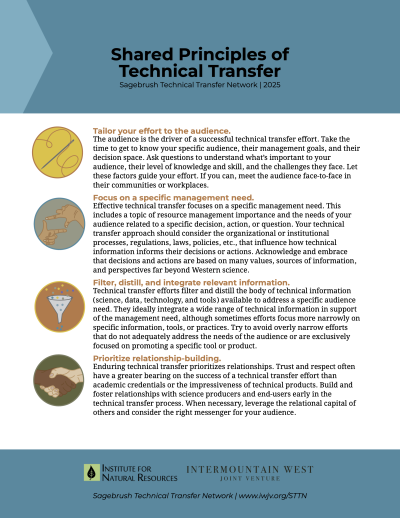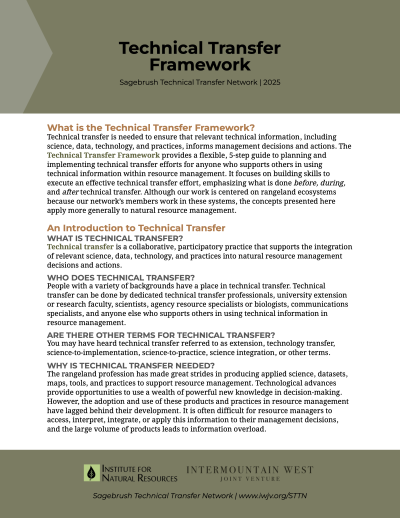



The Technical Transfer Framework

Technical transfer is needed to ensure that relevant technical information, including science, data, technology, and practices, informs management decisions and actions.
The Technical Transfer Framework, created by the Sagebrush Technical Transfer Network, provides a flexible, 5-step guide to planning and implementing technical transfer efforts for anyone who supports others in using technical information within resource management. It focuses on building skills to execute an effective technical transfer effort, emphasizing what is done before, during, and after technical transfer. The Technical Transfer Framework is supported by four Principles of Technical Transfer.
Although our work is centered on rangeland ecosystems because our network’s members work in these systems, the concepts presented here apply more generally to natural resource management.
The PRINCIPLES OF TECHNICAL TRANSFER
The Principles of Technical Transfer are a throughline of successful technical transfer efforts. Use them to guide technical transfer planning through the Framework below.




Tailor your effort to the audience
The audience is the driver of a successful technical transfer effort. Take the
time to get to know your specific audience, their management goals, and their decision space. Ask questions to understand what’s important to your
audience, their level of knowledge and skill, and the challenges they face. Let these factors guide your effort. If you can, meet the audience face-to-face in
their communities or workplaces.
Focus on a specific management need
Effective technical transfer focuses on a specific management need. This includes a topic of resource management importance and the needs of your audience related to a specific decision, action, or question. Your technical transfer approach should consider the organizational or institutional processes, regulations, laws, policies, etc., that influence how technical information informs their decisions or actions. Acknowledge and embrace that decisions and actions are based on many values, sources of information, and perspectives far beyond Western science.
Filter, distill, and integrate relevant information
Technical transfer efforts filter and distill the body of technical information (science, data, technology, and tools) available to address a specific audience need. They ideally integrate a wide range of technical information in support of the management need, although sometimes efforts focus more narrowly on
specific information, tools, or practices. Try to avoid overly narrow efforts that do not adequately address the needs of the audience or are exclusively focused on promoting a specific tool or product.
Prioritize relationship building
Enduring technical transfer prioritizes relationships. Trust and respect often have a greater bearing on the success of a technical transfer effort than academic credentials or the impressiveness of technical products. Build and foster relationships with science producers and end-users early in the technical transfer process. When necessary, leverage the relational capital of others and consider the right messenger for your audience.
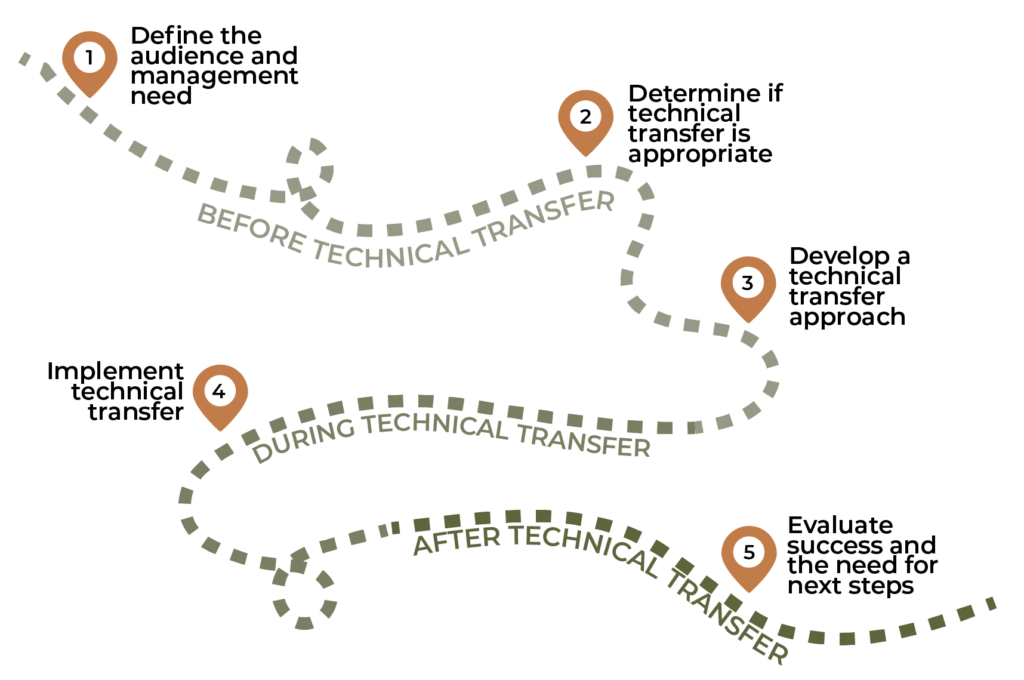
Dive into the Technical Transfer Framework
HOW TO USE THIS FRAMEWORK
The Technical Transfer Framework is meant to be used in a collaborative, participatory manner. We recommend reviewing the Framework independently for personal training. For implementing the Framework, we recommend moving through the steps with a team that includes technical transfer “doers”, the audience of the effort, and, when relevant, knowledge generators or keepers.
Before technical transfer…
① DEFINE YOUR AUDIENCE AND MANAGEMENT NEED



To center your effort, identify the “for who?” and the “why?”
The audience is a specific set of end users who are usually involved in decisions or actions related to resource management. They have a management need: for a topic of resource management importance, needs related to a specific management decision, action, or question. They may have a defined decision space or process for making and implementing decisions or actions. They may have specific ways in which they can or are required to incorporate technical information into management.
The technical transfer effort should help integrate relevant technical information, including science, data, technology, and practices, into the audience’s decision-making process. Each effort must be tailored to the audience’s social, cultural, and institutional context, decision process, and knowledge or skill level. Ideally, the audience is specific. However, on lower levels of the Proficiency Pyramid, it may be broad (Figure 2). A technical transfer effort may have multiple audiences, but approaches (Step 3) should be tailored to each.
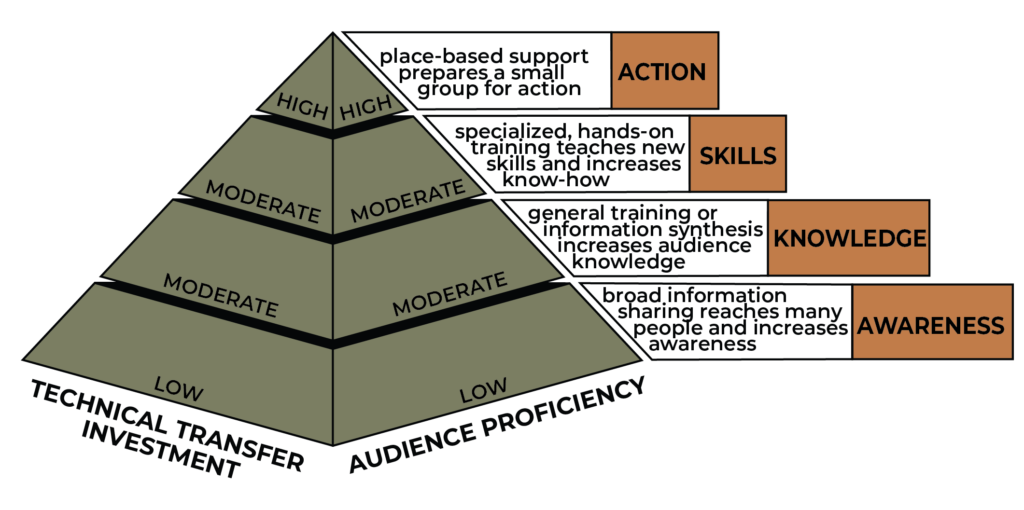
Resources for Step 1
Click to See Key Questions for Step 1
A. What is the management need? Why is this management need important? What resource management decision, action, or question is being addressed?
B. Who are your intended audience(s) or end-user(s)? What role(s) do they play in addressing the management need?
C. What is the desired level of proficiency you’d like the audience to have following technical transfer (Figure 2)?
D. What is your audience’s technical skill level relative to the topic?
E. How can your audience use information to inform a decision, action, or question?
② DETERMINE IF TECHNICAL TRANSFER IS APPROPRIATE


Verify you are using the appropriate tool for your audience’s needs
Technical transfer is not always the most effective solution to a management need. Before beginning a technical transfer effort, verify that technical transfer is appropriate for your situation by considering the table below. You do not need to meet all of these conditions, but if any of these “enabling conditions” are absent, you may need to consider additional approaches to strengthen your effort.
| TECHNICAL TRANSFER MAY BE MOST APPROPRIATE WHEN: | IF CONDITIONS ARE NOT MET, CONSIDER: |
|---|---|
| Data, science, or other information can influence the management need (i.e., it is not dictated by policy, law, regulation, etc.). Sometimes, technical information cannot change decisions or processes in resource management. Ensure your audience’s decision-making process can actually be informed by technical information before embarking on technical transfer. | Address policy considerations if policy dictates or inhibits decision-making. |
| A sufficient volume of actionable information (science, data, traditional or local knowledge, etc.) exists to inform management need. The information you are sharing must be supported by sufficient science, data, traditional or local knowledge, or technology to be actionable. Not every new innovation or research finding can or should be acted upon. Sometimes, more evidence and refinement may be needed before asking people to change their actions. Although there will always be uncertainty and knowledge gaps, technical transfer may be most appropriate when enough information has been accumulated to be compelling and actionable. | Facilitate the co-production of knowledge with an integrated technical transfer plan if more information is needed to bridge science and management. |
| You have relationships, trust, and credibility with an audience that can influence decisions or actions related to the management need. All technical transfer efforts should center relationships with the audience. Trust and credibility are needed for successful technical transfer. Researchers or outside entities may not be trusted, so your technical transfer team may need to include those already trusted by your audience. | Build relationships before implementing technical transfer if your team lacks trust and credibility with the audience. |
| The social and administrative conditions exist to set your effort up for success. Your audience is ready to act. Conservation readiness refers to the convergence of enabling social, administrative, and ecological conditions necessary for effective and durable conservation action. Technical transfer may not be appropriate if the right social and administrative conditions are not in place to support adoption. Your audience must also be willing and ready to change their perceptions, actions, and behaviors. | Use the Conservation Readiness Framework to move towards conservation readiness. |
| Your team has the capacity (time and skills) to address at least some technical transfer barriers for this management need. Technical transfer takes a diverse skill set and requires dedicated time and effort. Consider building capacity or teaming up with others. If capacity is limited, you may need to adjust your expectations for the level of proficiency you can achieve. | Consider joining the Sagebrush Technical Transfer Network to build your technical transfer skills. |
③ DEVELOP A TECHNICAL TRANSFER APPROACH




Tailor your approach to your audience’s needs and desired outcomes
Selecting an approach for your technical transfer effort is about increasing your audience’s proficiency in a focused, engaging, and participatory way. There is no one-size-fits-all technical transfer approach. Each effort should center its audience’s management need, social, cultural, and institutional context, decision process, and level of knowledge or skills.
Resources for Step 3
Click to See Key Questions for Step 3
A. What does success look like for this effort?
B. What are the learning outcomes or the main take-homes for your audience? What do you want them to walk away with?
C. How does your approach filter, distill, and integrate information from a broad body of knowledge? What are the barriers to the audience accessing, interpreting, and applying this information?
D. What format(s) will likely be successful for your management need, audience, and desired proficiency level (Figures 2 & 3)?
E. Who are the most effective messengers for your audience? Which individuals and institutions have trust and credibility with this audience and sufficient knowledge to carry out the technical transfer?
F. Are there other relevant research or technical transfer efforts that focus on this management need? If so, how can your work synergize with these efforts?
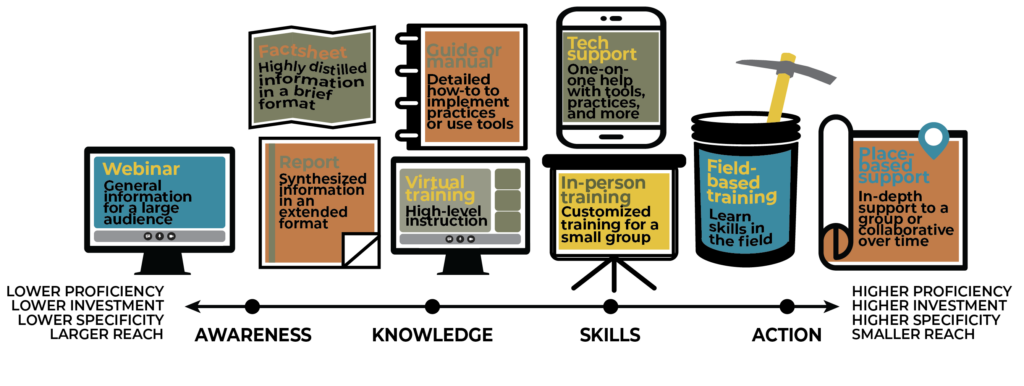
During technical transfer…
④ IMPLEMENT TECHNICAL TRANSFER




Follow your technical transfer approach and use best practices for a successful technical transfer effort
Key components of implementing a technical transfer effort include:
- Keeping it centered on the “why?” of the management need throughout.
- Empowering your audience, not just educating. After all, “telling ain’t training”! Where possible, seek opportunities to facilitate peer-to-peer learning, spark conversation among colleagues, and foster relationship-building among participants that will extend beyond the technical transfer effort. Integrate hands-on or other interactive activities as much as possible, and consider using multiple formats or approaches that address varying learning styles (Figure 3).
- Focusing on what the audience really needs to know. Be aware of information overload. Understand that adults learn best when information provides a personal benefit, relates to their experience, and can be used immediately. Rely on your 3-4 main messages, and reinforce them repeatedly. Use plain language when possible.
- Coming prepared. Ensure you have adequate capacity for facilitation and other needs to make the technical transfer run smoothly, especially for in-person events. Build flexibility into your approach to adapt to your audience’s needs. For example, in a workshop or webinar, leave a buffer for extra time for discussion in case it is needed.
After technical transfer…
⑤ REFLECT ON YOUR SUCCESS AND THE NEED FOR NEXT STEPS

Assess how you did and what’s next
Key components of assessing a technical transfer effort include:
- Assessing how your outcomes measured up to the vision of success you set before the effort was underway. Did your audience meet your desired learning outcomes or internalize the key take-home messages? For longer-term outcomes, are concepts being carried forward into the day-to-day work of your audience? Is there an increase in technical tools or a common language being used among your audience, where applicable?
- Considering your audience’s view of the effort’s success and potential for building and maintaining relationships. Are there opportunities to strengthen relationships with your audience, and would they work with you again?
- Evaluating if additional steps are needed to achieve success. Have you identified new technical transfer needs through your effort? Do you have any new information relevant to your effort? Is more support needed to increase the audience’s proficiency and confidence in the topic? Do you have the capacity to keep working on the topic?
- Reflecting on what went well and what you would do differently next time, including formal or informal ways to evaluate your effort. Consider using our Technical Transfer Reflection Worksheet to debrief with your team and document your lessons learned to benefit others working on tech transfer.
Access printable versions of this content
(The Planning Worksheet is a fillable PDF. The Reflection Worksheet is meant to be a choose-your-own-adventure, so you’ll need to record responses elsewhere. We’ve included pared down versions of each worksheet with questions only if you’d like to record there while viewing the worksheet in another window.)

